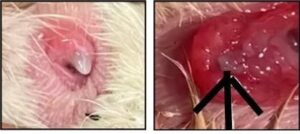Guidelines for Sexing Emus
Also see the full printable Guidelines for Sexing Emus
FACTS FOR THE FARMER
Guidelines
For
Sexing Emus
SEXING EMU
It is difficult to tell the difference between the sexes from 3 to 14 months because the growth rate of the sexual organs is nonexistent, often causing mistakes in gender identification. The sexual organs enlarge at puberty and then again at the onset of breeding season, after which there is a slight reduction in size until the next breeding season. For this reason, it is better to determine the sex at hatch, or wait until maturity.
VENT SEXING
CHICKS
Many farmers prefer to vent sex chicks immediately or prior to moving from the hatcher to the brooder for several reasons:
-
Permanent or semi-permanent IDs are being applied at this time so a notation of the chicks’ sex is appropriate.
-
Lack of manure.
-
Chicks are easier to handle.
In order to manually sex chicks you will need to be very gentle so you don’t hurt them. Never insert a finger into the cloaca as it could injure the chick. Wearing latex gloves, tum the chick upside down and very gently, part the feathers on either side of the cloaca.
Using the thumb and forefinger, apply a little pressure to either side in a gentle kneading motion to evert the sexual organs. If the chick is male, the phallus will show as a little gray or whitish stem with a white tip. A female will have a pink or purple to bluish triangular shaped clitoris similar in shape to a rosebud. If sexual organs are not well-defined, the chick is not kept for breeding.
The pictures below show the difference between day old male and female emu chick sex organs.
Male Female
MATURE EMU
For adult emu a finger can be inserted into the cloaca and the sexual organ can either be palpitated or gently everted and visually examined.
Always wear latex gloves for this process to protect both you and the emu. Some fam1ers use emu oil as a lubricant when sexing mature emus.
See Facts for the Emu Farmer – Handling and Transportation of Emu for information on how to restrain adults.
Palpitation
Palpation requires feeling for the presence of hard cartilage on the sexual organ. Hard cartilage indicates the presence of a phallus, lack of this cartilage indicates female. Palpitation
Visual Examination
In order to visually examine the sexual organs, they must be everted. Insert the gloved finger into the cloaca and feel under the sexual organ, applying firm pressure until it is everted.
Males: The non-erect phallus has a short firm cartilage base and an ostium or opening in the tip that contains the portion of non-cartilaginous phallus that extends during arousal.
Females: The clitoris will feel soft compared to the phallus and vary in size from ¾ inch to almost nothing. There will be no ostium in the tip.
Hermaphrodite: The presence of both male and female sexual organs in one individual is rare. These birds are not suitable for breeding.
DNA SEXING
This is the most reliable form of emu sexing. In DNA sexing the laboratory sends a sample collection kit to the farmer.
Following instructions, a blood or feather sample from the emu is collected and sent to a laboratory for gender identification.
Follow the lab instructions for feather collection. Ratite sex chromosomes are different from other bird species so it is best to use a lab that is experienced in DNA testing of Ratites. Results may take a week or more.
SEXING BY EAR
As chicks, emu make a whistling, chirping or cheeping sound. There is no way to tell them apart by sound. When they become adults, the sounds commonly made by each sex will change.
The ‘voice change’ begins when the birds are between 10 to 14 months old. At this time both sexes will be heard making grunting sounds. Soon after that the female goes through a physical change (the male does not) as her throat sac begins to develop. During this time the sounds she makes will vary from grunting to a guttural drumming.
By the time she is sexually mature, the female will have “found her voice” and it will be easily distinguished from that of a male grunt.
The female can usually drum in two pitches. One is a higher, faster sound made when excited or stressed. The other is a deeper, richer booming that sounds like a drum.
The male will not only make a variety of grunting sounds, varying from short stuttering grunts to deep gruff sounds. Males will also whistle to their chicks.
The most common time for booming and grunting is during evening hours or just before a rain.
________________
© American Emu Association
All Rights Reserved
(541) 332-0675 https://www.aea–emu.org
2 Comments
Leave a Comment

Founded in 1989, The American Emu Association is a non-profit trade association representing breeders, producers and marketers of emu meat, oil and other emu co-products. The emu industry is an alternative agricultural industry, dominated by the small farmer, who is devoted to humane and environmentally positive practices that will produce beneficial products for society. For more information about the American Emu Association (AEA) or the emu industry visit http://aea-emu.org


Hello!
Thank you for this very helpful information. I truly appreciate it. I’m just writing to let you know about a typo on the site. the word “palpitation” (rapid heartbeat) was used instead of “palpation” (examining with touch/fingers.) I wasn’t sure if you’d want to know so I thought I’d write just in case.
Have a nice day 🙂
Amy
I have 3 emu I need sexed so old tell me exactly what I need to do n how much for each, bird to be sexed. You can email nelsonken02@gmail.com text me at 812-620-8283. Or mail ken nelson 7929s organ springs rd, salem Indiana 47167